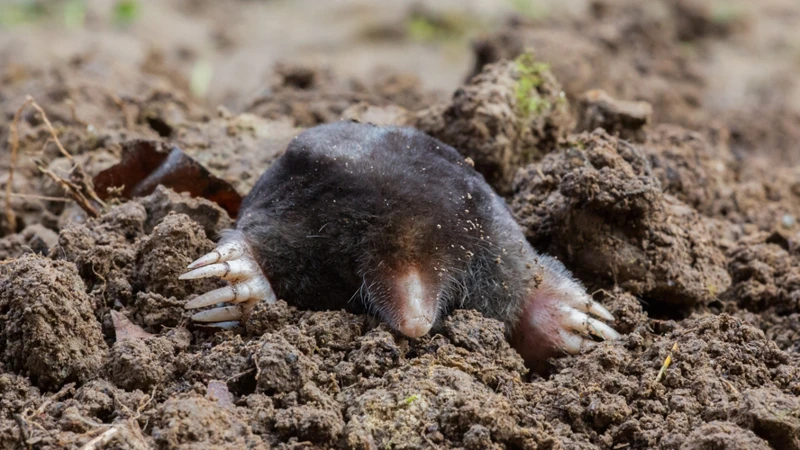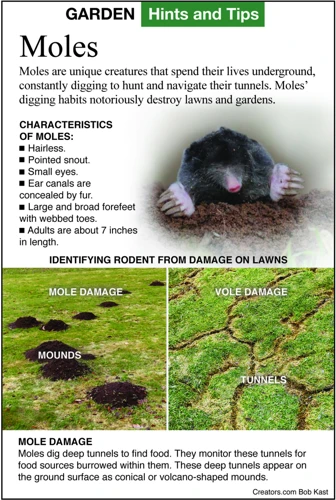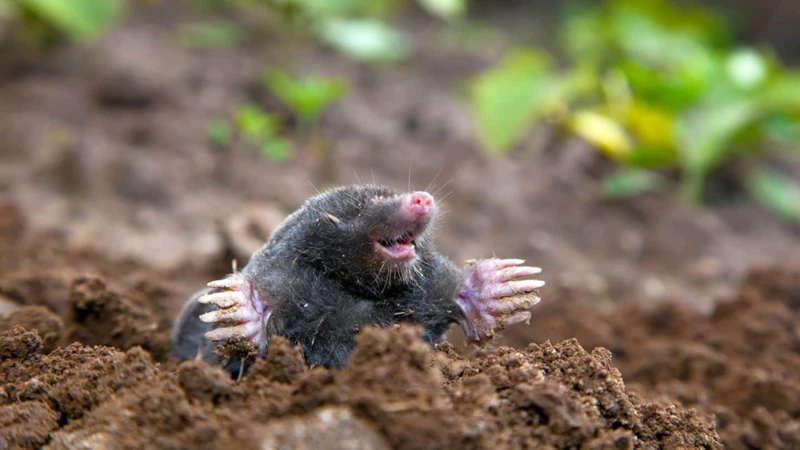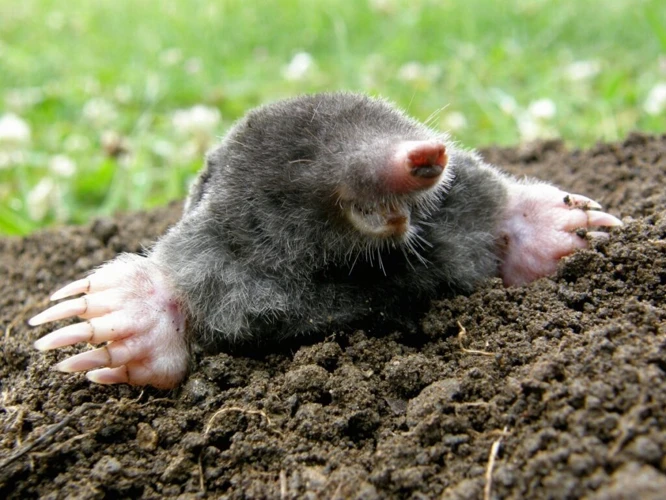Your lawn is one of the most important parts of your home’s curb appeal, and responsible homeowners strive to maintain a healthy, vibrant lawn. However, if you’ve noticed mysterious tunnels and molehills popping up on your lawn, you may be wondering what’s causing this damage. You may be perplexed as to how to manage these elusive creatures and prevent them from destroying your lawn. The answer to this problem may lie in understanding the diet of moles and their impact on your lawn’s health. In this comprehensive guide, we will explore the anatomy of moles, what they eat, why they feed on earthworms, how their diet affects your lawn’s health, and most importantly, preventive measures you can take to mitigate the damage. So, buckle up, and let’s get started on this informative journey.
The Anatomy of Moles

Have you ever wondered what goes on inside a mole’s body? These tiny creatures have a unique set of characteristics that help them thrive underground. Understanding the anatomy of moles can shed light on their behavior and why they eat what they do. From their sharp claws to their keen sense of smell, moles have evolved to be expert diggers and hunters. In this section, we’ll explore the different parts of a mole’s body and how they contribute to its survival. To learn more about moles’ diet and their nutritional needs, check out our nutritional needs of moles guide.
What Moles Eat: An Overview
Moles are insectivores, which means that their primary diet consists of insects, grubs, and worms. Here’s a detailed overview of what moles eat:
- Insects: Moles have a particular fondness for insects, such as ants, beetles, and termites. They dig tunnels through the soil and can detect the vibrations of these insects moving around, enabling them to locate them with ease.
- Grubs: Moles also feed on grubs, which are the larvae of various insects, such as beetles and cutworms. They search for grubs in the soil by sniffing them out using their sharp sense of smell. Contrary to popular belief, not all moles are after grubs.
- Earthworms: Earthworms are a staple in a mole’s diet. Moles love to eat earthworms due to their high protein content.
- Small vertebrates: Although it’s rare, moles can also feed on small vertebrates such as mice, shrews, and even small snakes.
It’s crucial to note that moles’ diet can vary depending on different factors such as the availability of food sources in their environment. It is common to see moles frequenting gardens or yards since they have a ready supply of insects and earthworms to feast on. If you’re struggling with a mole problem in your garden, you can find ways to modify your garden layout to repel moles. For more information about why moles visit your yard, you can check our article on /are-grubs-the-only-reason-moles-visit-your-yard/.
Why Moles Feed on Earthworms?
Moles are known for their diet of earthworms, which comprises up to 90% of their daily food intake. Indeed, earthworms are a staple for these small underground mammals. But why do moles feed on earthworms so much?
Moles are carnivores: Moles’ primary diet consists of insects, earthworms, and small invertebrates. They have a high metabolism and need to consume a large number of calories regularly. Earthworms are readily available and provide a significant source of protein and energy for moles.
Earthworms are easy prey: Earthworms are soft-bodied and are relatively easy for moles to catch and consume. Moles have keen senses of smell and touch, which help them locate and capture earthworms in soil.
Earthworms are nutritious: Earthworms are nutrient-rich, containing high levels of protein, amino acids, calcium, and other essential nutrients. Moles can digest earthworms’ soft bodies and extract essential nutrients from them.
Earthworms are abundant: One acre of soil may contain about a million earthworms, providing moles with consistent access to their primary prey.
However, while moles’ diet of earthworms is natural and necessary for their survival, it can have adverse effects on lawns and gardens. Moles’ burrowing and feeding habits can result in the destruction of grass roots and the soil structure, leading to a weakened, unhealthy lawn.
To prevent mole damage to your lawn, consider modifying your garden layout to repel moles or using non-lethal traps to capture and relocate the animals before they cause significant damage. For more information on moles’ impact on the garden and solutions to combat them, read our articles on moles’ diet and garden layout modification.
Moles’ Digestive System Explained
Moles have a relatively simple digestive system. They lack a gallbladder, so bile continuously flows into their small intestine to aid in the digestion of fatty foods. Moles are also unable to regurgitate food or ruminate, which means they cannot vomit. This is due to the positioning of their esophagus and stomach, which doesn’t allow for the reverse flow of food.
The Digestive Process:
• Moles have a short digestive tract, which means that food passes through their system quickly.
• Their muscular stomach aids in grinding up and breaking down food.
• The food then travels to the small intestine where it is further broken down and absorbed into the bloodstream.
• Undigested waste moves into the large intestine and exits the body through the anus, creating molehills in your lawn.
The Importance of Earthworms:
Earthworms are a favorite food of moles due to their high protein content. Moles have a very high metabolism, which means they need to consume large amounts of food to maintain their energy levels. Earthworms provide moles with the necessary nutrients to survive and thrive. However, this can have negative consequences for your lawn.
The Impact on Your Lawn:
Moles are known to tunnel through lawns in search of earthworms, creating unsightly molehills and damaging the roots of your grass. This can cause the grass to wilt and die, leaving your lawn looking patchy and unhealthy. The tunnels left behind by moles can allow weeds and other unwanted plants to take root in your lawn, further damaging its health and appearance.
Understanding the digestive system of moles and their dependence on earthworms can help you take steps to protect your lawn from their damage. There are several preventative measures you can take, such as using mole repellents, non-lethal traps, and eco-friendly methods, to keep moles at bay and maintain the health and beauty of your lawn.
The Impact of Moles’ Diet on Your Lawn’s Health

Your perfectly manicured lawn is a source of pride and envy, but what if an army of moles has taken over? Moles are notorious for their destructive habits, and their dietary preferences can have a serious impact on your lawn’s health. Understanding how their diet affects your lawn can help you take proactive measures to minimize the damage and keep your lawn looking lush and healthy. So, let’s delve deeper into the impact of moles’ diet on your lawn’s health and explore possible preventive measures.
How Moles Damage Your Lawn’s Health
Moles are known to be one of the primary culprits for damaging lawns, and their feeding habits are the primary reason behind it. Moles are insectivores and mainly consume earthworms, grubs, and other soil-dwelling invertebrates. However, their feeding pattern has a direct impact on your lawn’s health. Let’s take a closer look at how Moles damage your lawn’s health.
| Ways Moles Damages Your Lawn’s Health | How it Affects Your Lawn |
|---|---|
| Moles create tunnels and mounds | These tunnels and mounds ruin the smooth and even texture of your lawn, and the mounds act as a tripping hazard. |
| Decreased soil aeration | Moles’ tunnelling activity minimizes the soil’s oxygen intake, thus decreasing soil aeration. This decreases the turf’s root development and restricts its growth. |
| Exposing the Roots to Sunlight | Moles’ digging exposes the roots to the harmful UV rays, which can lead to drying and eventually killing the plants. |
| Disturbance to the soil food web | Moles feeding activities can disrupt the soil food web, leading to soil nutrient depletion, which can affect plant growth and health. |
| Increased susceptibility to pest attack | The tunnels created by Moles create an easy path for other pests, such as voles, to raid and feed on plant roots, leading to plant damage and yield reduction. |
As shown in the table, Moles’ digging and feeding activities don’t only create unsightly mounds, but they also decrease soil aeration, expose roots to harmful UV rays, disturb the soil food web, and increase the risk of other pests’ infestation. It’s important to mitigate Moles’ activities and maintain a healthy and beautiful lawn.
The Benefits of Earthworms for Your Lawn
Earthworms are small creatures that can have a BIG impact on the health of your lawn. They offer numerous benefits, including enhancing soil quality and promoting healthy root growth. Here are some of the top benefits of having earthworms in your lawn:
- Soil Aeration: Earthworms burrow into the soil, creating tunnels that allow air, water, and nutrients to penetrate deep into the earth. This helps relieve soil compaction and increases soil aeration, which is essential for plants to thrive.
- Nutrient Recycling: Earthworms consume organic matter, such as dead leaves and grass clippings, and excrete it as nutrient-rich castings. These castings contain vital nutrients, including nitrogen, phosphorus, and potash, which are essential for healthy plant growth.
- Improved Soil Structure: Earthworms help create a healthy soil structure by breaking down organic matter and improving soil texture. This makes the soil less prone to erosion and improves water-holding capacity.
- Promotes Root Growth: Earthworms excrete mucus that helps bind soil particles together, creating a porous soil that is ideal for root growth. This helps plants establish stronger root systems and absorb essential nutrients more efficiently.
- Reduced Soil pH: Earthworms excrete calcium carbonate, which is a natural buffer that helps maintain healthy soil pH levels. This is important because an imbalanced pH level can make it difficult for plants to absorb nutrients from the soil.
The benefits of earthworms in your lawn are numerous and can have a significant impact on the health and vitality of your grass and plants. Encouraging earthworm activity in your lawn is a great way to promote a healthy and thriving ecosystem.
Can Moles Ever Be Beneficial for Your Lawn?
While it may seem like mole infestations are always a negative thing for your lawn, there are actually some potential benefits to having these small mammals around. Let’s take a look at some potential benefits and drawbacks of moles’ presence in your lawn:
| Potential Benefits | Potential Drawbacks |
|---|---|
| Moles can help control the population of other pests in your lawn, including insects and grubs that can damage your plants. | Moles’ burrowing activity can disrupt the root systems of your lawn, causing damage and possibly even killing your grass. |
| The tunnels and burrows created by moles can help aerate your soil, improving its overall health and making it easier for plants to grow. | Large numbers of moles in your lawn can make it difficult to mow or walk on the grass, as their burrows create uneven terrain. |
| The presence of moles can attract predatory animals, such as hawks and snakes, to your lawn, which can help keep other pests under control. | Moles can be difficult to remove once they’ve established a presence in your lawn, which can be frustrating for homeowners looking to maintain a pristine yard. |
So, can moles ever be beneficial for your lawn? While the potential benefits listed above may seem appealing, it’s important to remember that the drawbacks can be significant. Ultimately, it’s up to you to decide whether the benefits of having moles in your lawn outweigh the potential costs. If you do decide that you want to remove moles from your lawn, there are a variety of methods available, including repellents, traps, and eco-friendly options.
Preventive Measures to Mitigate the Damage

As a homeowner, dealing with a mole infestation in your lawn can be frustrating, and the damage caused by these creatures can be costly to repair. Fortunately, there are preventive measures you can take to mitigate the damage caused by moles. From mole repellents to non-lethal traps, there are several solutions available to keep your lawn healthy and pest-free. In this section, we will explore various methods for combating mole infestations and protecting your lawn.
Moles Repellents: Do They Work?
It’s understandable why many homeowners would turn to mole repellents as a solution to combat moles’ infestation. However, the big question is, do they actually work?
There are several types of mole repellents available in the market. These include castor oil-based products, garlic and essential oil sprays, ultrasonic devices, and granules coated with chemicals like thiram, castor oil, or capsaicin.
The Effectiveness of Mole Repellents
Unfortunately, scientific research on the efficacy of mole repellents has not been very promising. Several studies have suggested that these repellents are largely ineffective. For example, a study from Purdue University found that castor oil repellents had no significant effects on the behavior of moles. Another study from the University of Nebraska-Lincoln found that thiram-coated granules had no effect on reducing mole activity in lawns.
Table:
| Type of Repellent | Effectiveness |
|---|---|
| Castor Oil-Based Products | Not Effective |
| Garlic and Essential Oil Sprays | Not Effective |
| Ultrasonic Devices | Not Effective |
| Granules Coated with Thiram, Castor Oil, or Capsaicin | Not Effective |
Why Do Mole Repellents Fail?
One possible reason for the failure of mole repellents could be attributed to the fact that moles are solitary animals that roam underground tunnels, making them difficult to target with repellents. Moles have a keen sense of smell, and they can differentiate between their prey and a foreign scent.
Another reason why mole repellents might not work is that they are often used in conjunction with lethal trapping, poisoning, or flooding, which creates a stressful environment for moles. Consequently, moles may dig deeper underground, rendering the repellents useless.
The Bottom Line:
While there is no harm in trying out different mole repellents as an option for controlling moles, it’s important to note that research suggests that they are largely ineffective. It’s imperative to employ more holistic and eco-friendly methods to prevent moles’ infestation and protect your lawn’s health.
Non-Lethal Traps: Effective Ways to Keep Moles at Bay
There are a variety of non-lethal traps available that are effective in keeping moles at bay without causing them harm. These traps are great alternatives to chemical repellents and other lethal methods of pest control, which can harm other wildlife and the environment. Here are some of the most effective non-lethal traps you can use to control mole infestations:
| Bottle Trap | Outward-Opening Trap | Tunnel Trap |
|---|---|---|
| A bottle trap can be made using a plastic bottle with the top portion cut off and inverted. The trap is set by digging a hole where the mole is active and placing the bottle in the hole. When the mole enters the hole, it falls into the bottle and gets trapped. | The outward-opening trap is simply a barrier placed in the mole’s path that forces it to dig outward to create a new tunnel. The trap is set by first locating an active mole tunnel and digging a hole in the tunnel where the trap will be placed. Then, a perforated barrier is installed that forces the mole to dig outwards. | A tunnel trap is a spring-loaded device that is placed inside a mole tunnel. The trap is set by digging a hole in the mole tunnel where the trap will be placed. The tunnel trap is then placed in the hole and set so that it will spring shut when the mole trips the trigger. |
These non-lethal traps may take some time and effort to set up, but they are an effective way to control mole infestations without harming the environment. Before setting up any type of trap, it is important to identify active mole tunnels and choose the appropriate trap for the situation. It may also be helpful to seek advice from a pest control professional or lawn care expert.
Eco-Friendly Methods to Combat Moles’ Infestation
There are several eco-friendly methods that can help you combat moles’ infestation without harming them or the environment. Here are some of them:
- Plant Natural Deterrents: Certain plants are known to repel moles, such as daffodils, alliums, and marigolds. Planting them around your lawn can help keep moles at bay.
- Use Castor Oil-Based Repellents: Castor oil-based repellents are organic and safe for the environment. They are known to drive moles away by making the soil unpleasant for them to burrow. You can either buy a castor oil-based repellent or make one at home by mixing castor oil with water and dish soap.
- Opt for Vibrating Repellents: Vibrating repellents work by emitting vibrations that mimic the sound of a predator approaching. This scares moles away and discourages them from burrowing in your lawn. Some vibrating repellents are solar-powered, making them an eco-friendly option.
- Create a Barrier: You can create a physical barrier around your lawn to prevent moles from entering. Surround your lawn with chicken wire or mesh, bury it at least two feet deep, and make sure the wire extends a few inches above ground level to prevent moles from burrowing under it.
- Encourage Natural Predators: Moles have a few natural predators, such as hawks, owls, and snakes. Encouraging these predators to inhabit your garden can help keep moles at bay. You can attract them by building nest boxes or planting vegetation that provides shelter and food for them.
Keep in mind that these eco-friendly methods might not work for all situations or types of moles. It’s important to identify the type of mole infesting your lawn and the severity of the infestation before trying any method. If the infestation is severe or persists after trying eco-friendly methods, it might be best to seek professional help.
Moles’ Diet: Is it a Red Flag to Your Lawn’s Health?
The diet of moles can indeed be a red flag for the health of your lawn. As we have seen earlier, moles primarily feed on earthworms, which are essential for maintaining a healthy lawn. Earthworms aerate the soil, enrich it with essential nutrients, and augment its water-holding capacity. Their burrows also allow oxygen and water to penetrate deep into the soil, thus promoting root growth and microbial activity, which are crucial for the vitality of your lawn.
However, moles’ voracious appetite for earthworms can deplete their population, leading to a decline in the lawn’s health. This can manifest in various ways, such as the formation of dead patches, stunted growth, weak root systems, and increased susceptibility to pests and diseases. The exaggerated mounds and tunnels created by moles can further damage the grass roots and expose them to the elements.
If you have noticed a significant population of moles in your lawn, it is essential to take preventive measures to mitigate their damage. You can follow techniques like using mole repellents, non-lethal traps, or eco-friendly methods to control their infestation. You can also improve the soil quality by adding compost, organic materials, and fertilizers to encourage earthworms to thrive.
It is crucial to understand that while moles can cause substantial damage to your lawn, they are not entirely detrimental. Moles also feed on harmful insects, grubs, and larvae, which can be a menace to the health of your lawn. It is essential to adopt a balanced approach that manages the mole population while preserving the ecological integrity of your lawn.
The diet of moles can certainly raise a red flag to your lawn’s health, but it is not an insurmountable challenge. By being proactive and adopting a holistic approach, you can mitigate the damage caused by moles and ensure the vitality and longevity of your lawn.
Conclusion
In conclusion, it can be said that moles can have a significant impact on the health of your lawn. Their diet primarily consists of earthworms, which are beneficial for the lawn’s soil health. However, the damage caused by moles’ digging and tunneling can outweigh the benefits of earthworms in the long run.
It is important to take preventive measures to mitigate the damage caused by moles. While moles repellents may not always be effective, non-lethal traps and eco-friendly methods can help keep the infestation under control.
Furthermore, it is essential to maintain a healthy lawn to discourage moles from making it their home. This means keeping the soil moist and aerated, and avoiding over-fertilization.
In summary, understanding the impact of moles’ diet on your lawn’s health and taking appropriate measures can help ensure a healthy and lush lawn. So, stay vigilant and take action before the mole population gets out of control.
Frequently Asked Questions
What do moles eat besides earthworms?
Moles also eat insects, grubs, and other small invertebrates found in the soil.
Will removing earthworms from my lawn deter moles?
No, moles will continue to search for food in your lawn even if there are no earthworms present. It’s also not recommended to remove earthworms, as they provide many benefits to the soil and overall lawn health.
How can I tell if there are moles in my lawn?
You can identify mole activity in your lawn by the raised ridges and tunnels they leave behind. These ridges are often in a line and may appear overnight.
Can moles spread disease to humans?
No, moles are not known to carry or spread any diseases that affect humans.
Do mole repellents actually work?
The effectiveness of mole repellents is debated, but many gardeners have reported success with certain types. However, it’s important to note that no repellent is 100% guaranteed to work and may require repeated applications.
Are non-lethal mole traps humane?
Non-lethal mole traps are designed to be humane and release the mole unharmed. However, it’s important to handle the traps properly and release the mole in a suitable location away from your lawn.
Can moles see and hear?
Moles have very small eyes and ears, but they do have the ability to detect light and low-frequency sounds.
What is the lifespan of a mole?
The lifespan of a mole varies by species, but most live for around 2-3 years in the wild.
Why do moles tunnel under my lawn?
Moles tunnel under the lawn in search of food and to create nesting chambers. The soil under your lawn may also provide a more accessible environment for them to burrow in.
Are there any natural predators of moles?
Yes, natural predators of moles include owls, hawks, foxes, and snakes.







